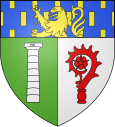Fourg
| Fourg | ||
|---|---|---|

|
|
|
| region | Bourgogne-Franche-Comté | |
| Department | Doubs | |
| Arrondissement | Besançon | |
| Canton | Saint Vit | |
| Community association | Loue-Lison | |
| Coordinates | 47 ° 6 ' N , 5 ° 49' E | |
| height | 250-445 m | |
| surface | 12.10 km 2 | |
| Residents | 380 (January 1, 2017) | |
| Population density | 31 inhabitants / km 2 | |
| Post Code | 25440 | |
| INSEE code | 25253 | |
| Website | www.fourg-village.com | |

|
||
Fourg is a French municipality with 380 inhabitants (as of January 1 2017) in Doubs in the region Bourgogne Franche-Comté .
geography
Fourg is located at 270 m , west of Quingey , about 23 kilometers southwest of the city of Besançon (as the crow flies). The village extends on the western edge of the Jura , at the northern foot of the Chanois ridge , on the eastern edge of the Saône lowlands and the forest area of Forêt de Chaux .
The area of the 12.10 km² large municipality covers a section of the western French Jura. The main part of the area is taken up by the plain between the Doubs and Loue rivers , which lies at an average of 270 m. In the area of Fourg it is mainly made up of arable and meadow land. To the west, the municipal soil extends into the extensive forest area of the Forêt de Chaux and thus into the headwaters of the Clauge (tributary of the Doubs). In the south, the community area extends over the slope Bois de la Côte to the wooded ridge of the Chanois . The highest elevation of Fourg is reached here at 445 m.
Neighboring municipalities of Fourg are Courtefontaine and Villars-Saint-Georges in the north, Byans-sur-Doubs in the east, Liesle in the south and Chissey-sur-Loue in the west.
history
Fourg is first mentioned in a document in 1275 under the name Fourz . Over time, the spelling changed via Four (1306) and Fourt (1407) to the current name, which has been documented since 1584. In 1281 Hughes de Montferrand built a castle in Fourg, thus laying the foundation for the Fourg domain. Together with Franche-Comté , the village came to France with the Peace of Nijmegen in 1678.
Attractions
The village church of Saint-Germain was built from 1766 to 1767. Only a few remains of the former castle are visible. Various farmhouses in the characteristic style of Franche-Comté from the 17th to 19th centuries have been preserved in the town center.
population
| Population development | |
|---|---|
| year | Residents |
| 1962 | 201 |
| 1968 | 195 |
| 1975 | 156 |
| 1982 | 180 |
| 1990 | 234 |
| 1999 | 254 |
| 2006 | 314 |
| 2016 | 364 |
With 380 inhabitants (as of January 1, 2017), Fourg is one of the small communities in the Doubs department. After the population had decreased markedly in the first half of the 20th century (430 people were still counted in 1881), there has been significant population growth again since the mid-1970s.
Economy and Infrastructure
Until well into the 20th century, Fourg was a village dominated by agriculture (arable farming, fruit growing, viticulture and cattle breeding) and forestry. In the 19th century in particular, village life was determined by brick production. Today there are some local small businesses. In the meantime, the village has also turned into a residential community. Many workers are commuters who work in the larger towns in the area.
The village is located away from the major thoroughfares on a department road that leads from Fraisans to Liesle. Another road connection is with Byans-sur-Doubs.
literature
- Le Patrimoine des Communes du Doubs. Volume 2, Flohic Editions, Paris 2001, ISBN 2-84234-087-6 , pp. 1045-1047.

